
Theretra latreillii, the pale brown hawk moth, is a moth of the family Sphingidae described by William Sharp Macleay in 1826. It is found in most of Asia, including Borneo, China, Hong Kong, the Philippines, Taiwan and also throughout the tropical and temperate regions of Australia.

Utetheisa pulchelloides, the heliotrope moth, is a moth of the family Erebidae. It is found in the Indo-Australian region including Borneo, Hong Kong, New Zealand, Papua, Seychelles, most of Australia,Tenerife and La Línea de la Concepción [Cádiz]. The species was first described by George Hampson in 1907.
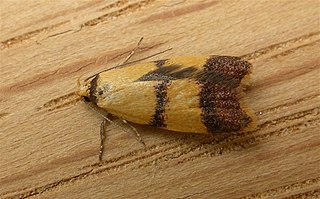
Heteroteucha translatella is a moth of the family Oecophoridae. It is found in Australia, where it has been recorded from Queensland, the Australian Capital Territory, Victoria and Tasmania.

Condica is a genus of moths of the family Noctuidae. The genus was erected by Francis Walker in 1856.

Hippotion velox, the dark striated hawkmoth, is a species of sphingid moth or the family Sphingidae. The species was described by Johan Christian Fabricius in 1793.

Ophisma gravata is a moth of the family Noctuidae first described by Achille Guenée in 1852. It is found from the Indo-Australian tropics of India, Sri Lanka, to Okinawa, Taiwan, the Caroline Islands, New Guinea, eastern Australia and New Caledonia.

Trigonodes hyppasia, the triangles or semi-looper, is a moth in the family Erebidae. The species was first described by Pieter Cramer in 1779. It is largely cosmopolitan, found throughout Borneo, Fiji, India, Maldives, Nepal, Sri Lanka, São Tomé and Príncipe, Taiwan, Thailand, Zimbabwe, northern Australia, and almost all African countries.
Trichoplusia lectula is a moth of the family Noctuidae first described by Francis Walker in 1858. It is found throughout Asia, including the Indian subregion, Sri Lanka, Thailand, Borneo, Java, Japan, as well as Western Australia and Queensland.
Condica concisa is a moth of the genus Condica first described by Francis Walker in 1856. The males and females can be hard to tell apart, as they are mostly the same colour (brown), but a distinguishing feature which helps to identify the moth's gender is that the hindwing of the male is white, whereas the female hindwing is light brown. The moths are quite abundant, as they can be found from the northern part of Argentina to Florida and Texas.

Condica dolorosa is a moth of the family Noctuidae. It is found in the Indo-Australian tropics, including Borneo, Hawaii, Hong Kong, India, Sri Lanka, Taiwan and Queensland in Australia.

Condica illecta is a moth of the family Noctuidae. It is found in both the Indo-Australian and Pacific tropics, including Borneo, Hawaii, Hong Kong, India, New Guinea, the Society Islands, Taiwan and Queensland and New South Wales in Australia. It is also present in New Zealand.
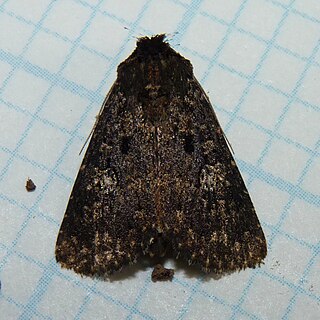
Condica vecors, the dusky groundling, is a moth of the family Noctuidae. The species was first described by Achille Guenée in 1852. It is found from Newfoundland to Florida, west to Arizona and north to Ontario.

Gesonia obeditalis is a species of moth of the family Noctuidae first described by Francis Walker in 1859. It is found from eastern Africa, the Seychelles, the Maldives and the Oriental tropics of India, Myanmar, Sri Lanka east to the Philippines, the Sula Islands and Australia. The adult moth has brown wings with a scalloped dark brown band near the margin. The hindwings are similar in pattern to the forewings but are a paler shade of brown.

Condica punctifera is a moth of the family Noctuidae first described by Francis Walker in 1857. It is found in southern Florida and on the Bahamas, Cuba, Jamaica, Hispaniola and Puerto Rico.
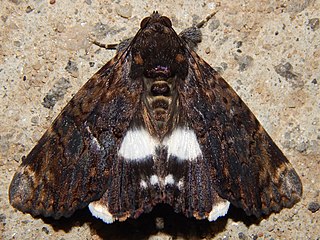
Nagia linteola is a species of moth in the family Erebidae first described by Achille Guenée in 1852. This species occurs in South Africa, the Democratic Republic of the Congo, Yemen, the Comoros, Mauritius, Madagascar, Indonesia (Borneo), India, Sri Lanka, Myanmar, Thailand and in Australia, where it has been recorded from Western Australia, the Northern Territory, Queensland and Victoria.
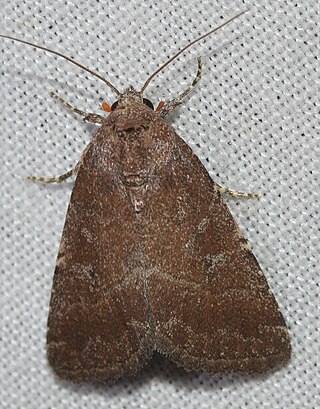
Condica viscosa is a species of moth in the family Noctuidae. It was described by Christian Friedrich Freyer in 1831. It is found from southern Europe and North Africa to Arabia and the southern parts of western Asia. The habitat consists of lowland areas near the coast, including dry slopes, road side verges, dry river beds or fallow land.
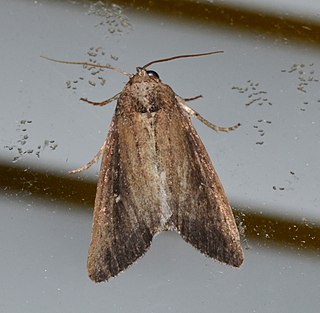
Condica videns, the white-dotted groundling moth, is a moth of the family Noctuidae. It is found in North America, where it has been recorded from Texas to Florida, north to Quebec and west to Alberta.

Erygia apicalis is a moth of the family Erebidae first described by Achille Guenée in 1852. It is found from the Indo-Australian tropics of India, Sri Lanka to Japan, Australia and the Solomon Islands. The habitat consists of lowland areas, including dry heath forests and softwood plantations.
Ericeia sobria is a moth in the family Erebidae. It is found in Kenya, South Africa, Gambia, Borneo, New Guinea and Australia, where it has been recorded from Queensland and New South Wales.
Hypena mandatalis, is a moth of the family Erebidae first described by Francis Walker in 1859. It is found in the Indian subregion, Pakistan, Sri Lanka, Borneo, Sulawesi and Australia.















